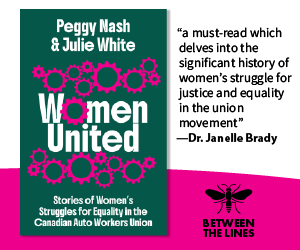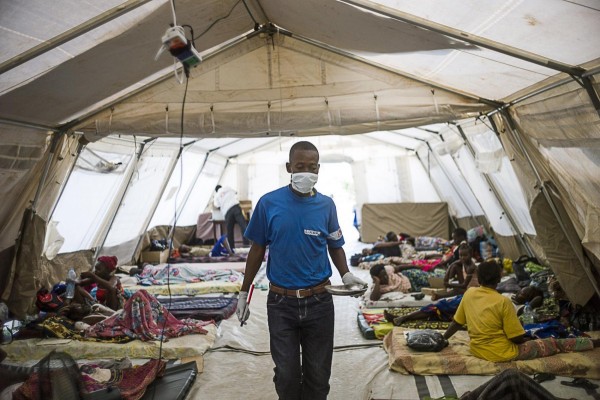Hounding Toronto’s homeless
Clarke: In the neoliberal city, the dominant political approaches treat housing as a commodity, not as a human right

A homeless camp in Toronto’s Trinity Bellwoods Park was cleared out by police on June 22, 2021, after protestors and residents were removed from the area. Photo by Hector Vasquez.
On June 22, a powerful force of police and private security guards descended on Toronto’s Trinity Bellwoods Park to drive out homeless people who had sought safety and shelter there. It was a particularly high profile and brutal operation that was part of an ongoing effort to evict those who have been forced to camp in city parks in order to survive.
The city’s Chief Communications Officer, Brad Ross, predictably trotted out the standard talking points to justify this attack on homeless people. He suggested that shelter spaces were readily available and offered greater safety than sleeping in parks. He also asserted that housing options exist for the victims of Toronto’s crisis of homelessness. For good measure he suggested that this massive show of force was not to intimidate the residents of the park but to deal with dangerous “protesters” who might pose a security threat.
For Ross and those he answers to, the readiness of allies to show their solidarity with homeless people under attack is decidedly inconvenient. Indeed, this support was instrumental in pressuring the authorities to finally promise permanent housing to those in the park. Anyone at all familiar with the state of the overwhelmed shelter system, compounded as it is by the pandemic crisis, and the dire lack of housing in this city, will understand how preposterous Ross’s evasions really are.
do not look away. encampments are a symptom of a chronic policy failures on homelessness. we cannot police people out of poverty — need all levels of government committed to ending this public health crisis with housing for all. pic.twitter.com/IKxxd90nG4
— Andrew Baback Boozary MD (@drandrewb) June 22, 2021
Hiding the problem
The dramatic police mobilization that was unleashed drew comparisons to the clearing of the “Tent City” homeless encampment on the city’s waterfront some 20 years ago. At that time, 140 people were driven from their makeshift homes by a massive security operation. This action also took place at a moment when Toronto’s governing authorities concluded that the efforts of homeless people to survive had come into sharp conflict with development plans and business interests. Then as now, the concern was not to tackle the unfolding disaster of homelessness but rather to ensure that the problem was hidden from view.
While the devastating impact of the pandemic and its toll on the highly vulnerable homeless population has been the immediate driving force, the major increase in homeless encampments in Toronto over the recent period has grown out of a long term exacerbation of Toronto’s housing crisis. In the 28 years I worked as an organizer with the Ontario Coalition Against Poverty (OCAP), from 1990 on, I saw the appalling situation of homelessness in Toronto go from bad to very much worse. It’s important to note that conditions of literal destitution are only the sharpest expression of a broader problem of poverty and precarious housing. For every person that is put on the streets, there are many others who pay the rent at the cost of going short on basic nutrition and who are but steps away from being unhoused themselves.
An urban environment in which hundreds of thousands are at risk of losing their housing has been described as the neoliberal city, “a laboratory for austerity, governmental decentralization, and market-based solutions to urgent public problems such as affordable housing, criminal justice, and education.” A concerted drive to cut systems of social housing and income support has combined with the extreme commodification of housing to ensure an oversupply of upscale housing and an extreme shortage of affordable options.
Inevitably, in such a situation, the growing numbers of those who simply can’t obtain or retain housing ensures that the homeless shelters are bursting at the seams and that the conditions in them become unbearable on those occasions when it’s possible to find a place for the night. Inevitably too, this induces people to opt instead for sleeping rough in parks and ravines throughout the city.
This was the state of things when the pandemic struck. Like other neoliberal cities, Toronto had weakened the elements of the social infrastructure that were needed to cope with the public health emergency that ensued. The virus followed the pathways of class-based and racialized inequality and vulnerability that had been laid down for it to find those it could most easily infect. The homeless shelters were prime targets in this regard. Official spokespersons for City Hall may confidently assert that the shelter options they claim are readily available are safer than public parks but they will never have to put their theory to the test. The homeless themselves have frequently decided that conditions are safer and more livable when they join with others to establish and maintain an encampment.
Already, by September of last year, municipal authorities were greatly alarmed by the profusion of homeless camps that their own policies had engendered. Mayor John Tory suggested that Toronto was being “overwhelmed” by the efforts of homeless people to survive the pandemic crisis. An ongoing effort to harass and intimidate encampment residents ensued, but it faced determined resistance, with allies of the homeless—often people from surrounding neighbourhoods—doing all they could to resist evictions. Clear demands for a just response to the crisis were advanced by organizations like the Shelter and Housing Justice Network (SJHN), the Encampment Support Network and OCAP.
The mayor and his top officials, however, are not motivated by any considerations of justice for homeless people. For them, the needs of developers, speculators and major retailers are the clear priority. The visibility that the homeless crisis has assumed during the pandemic is deeply troubling for them. So concerned are they to contain this problem that the city even took legal action against a carpenter who had begun placing small, insulated shelters in public parks.
Remnants of an abandoned encampment under Toronto’s Sir Isaac Brock Bridge. Photo by John Brownlow/Flickr.
After the pandemic
If the worst of the pandemic is indeed behind us, we may wonder what policies governments will adopt in its wake. There are competing ideas among those in power in this regard, while the political left is divided on the question of whether an extended period of economic stimulation is likely. Certainly, here in Ontario, the Doug Ford Tories seem ready to serve up a menu of austerity. In Toronto, the recent attack on the homeless doesn’t suggest a kinder, gentler approach is being considered. It doesn’t appear that the decades-long agenda that brought the homeless disaster to its present level is about to be reversed.
In the neoliberal city, the dominant political approaches that are pursued treat housing as a commodity and not as a human right. The profit imperative takes priority over those who have been cast aside in the process of upscale redevelopment.
While the creation of truly affordable housing and a response to the disaster of homelessness are lacking, the swollen Toronto police budget is zealously protected by the bulk of the city council, even as calls to defund the police resonate internationally. The neoliberal city needs its enforcers as a matter of great priority. Those who are denied the right of housing must not be allowed to become too visible. If they seek shelter and safety in public parks, they will soon learn that, while there may be no housing or even adequate shelter available for them, there will be no lack of police batons to drive them from view.
John Clarke is a writer and retired organizer for the Ontario Coalition Against Poverty (OCAP). Follow his tweets at @JohnOCAP and blog at johnclarkeblog.com.










